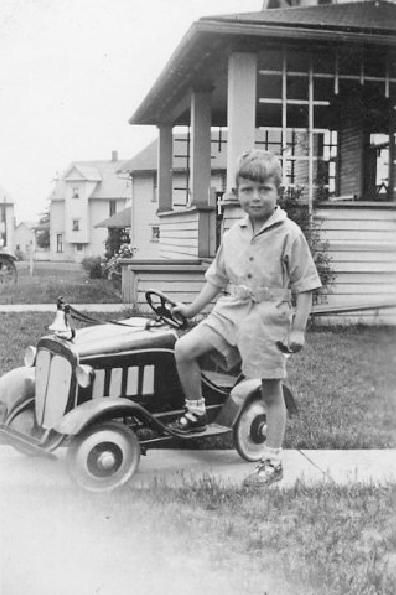
oo Figure 1.--This 1931 snap shot sure looks like it was taken in America. Both the boy and the neigborhood looks American, but the photograph was being sold in Germany. Notice the great bell on his kiddie car. |

|
We have seen kiddie cars in many different countries. They seem most common in America where of course automobiles were most common. It was also where because of economic affluence that parents had the money to but relatively expensive toys like bikes, trikes, and kiddie cars. The cars were made both with and without pedal drive mechanisms. Thus they are also called p[edal cars. We see them made in all kinds of shapes in America. The most common of course was the autmobile style, but we see other styles like airplanes as well. The United States was not the only county where they were popular. We see them in many European countries as well. We know less about kiddie cars in Europe, especially because we have been able to find far fewer photographic images than in America.
Pedal cars began to appear at about the same time cars did. One source reports pedal cars first appeared in the early-90s. These early pedal cars pf course did not look much like cars, but the cars of the prriod don't look much like our modern idea of a car. We begin to see pedal cars more commonly in the early-20 centuty. They ptoved very popular with the chikdren, mostly boys. Pedal car manufacturers began masking pedal cars that resembled the major cars of the era (Buick, Cadillac, Packard, Pierce Arrow, Pope and Winton, and many were other classic makes (1910s). Many specialized vehickes appeared in the 1920s. An pedal car companies followed suit with new types like roadsters. We see pedal cars with large fenders, shiny radiators, and artistic hood ornaments(1920s). Ansd with Lindburg's flight we begin to see airplane pedal cars. Cars got larger and heavier and we begin to see stramlining (1930s). Some of the largest pedal cars appeared at this time. Several companies made pedal cars, including American, National, Gendron, and Steelcraft. We also see artillery wheels with large plated hubcaps. The 1940s after Pearl Harbor, the production of pedal cars virtully stopped (December 1941). Both metal and rubber were strategic materials needed for the war effort. After the War, we begin to see military vehicles as well as new car models (1940s). We begin to see cars with tailfins in the 1950s, emulating jet aircradt and futuristic space cradt. This too was refected in the fantasy pedal cars (1950s). We also see hot rods. Garton and Murray Ohio were two of the most popular pedal car manufacturers. Pedal cars appeared with decals and plastic trim (1960s). A few appeared with spiffy metallic finish. Garton, Murray and AMF produced a range of pedal cars. This ended the classic period of American pedal cars> We cheap see platic versions in the 1970s. Pedal cars are a good indicator of relative affluence as it was something that children did not generally get unless the family was doing well.
We notice pedal cars in England, but they were not something most children had. An English reader writes, "Only parents who had better paying jobs could afford a pedal car toy for their children. Some of my friends had pedal cars and it was a great feeling being allowed to play in it for a few minutes. Usually one looked on wishing to be in the drivers seat. It was with feelings of envy as the rest of the group trotted along side the car as it moved along the street. I think this toy was associated with little children aged 6 to about 8.
I have a coloured picture of a peddle car in a shop window 1920s vintage." Another Brirish reader tells us about his family. They had both a tricucle and a pedal car that he and his brother played with in their back garden.
Navigate the Boys' Historical Clothing Web Site:
[Return to the Main kiddie car page]
[Return to the Main outdoor activities vehicle page]
[Introduction]
[Activities]
[Biographies]
[Chronology]
[Clothing styles]
[Countries]
[Literary]
[Bibliographies]
[Contributions]
[FAQs]
[Glossaries]
[Images]
[Registration]
[Tools]
[Boys' Clothing Home]
Navigate the Boys' Historical Clothing Web Site:
[Sailor suits]
[Sailor hats]
[Buster Brown suits]
[Eton suits]
[Rompers]
[Tunics]
[Smocks]
[Pinafores]
[Sandals]
